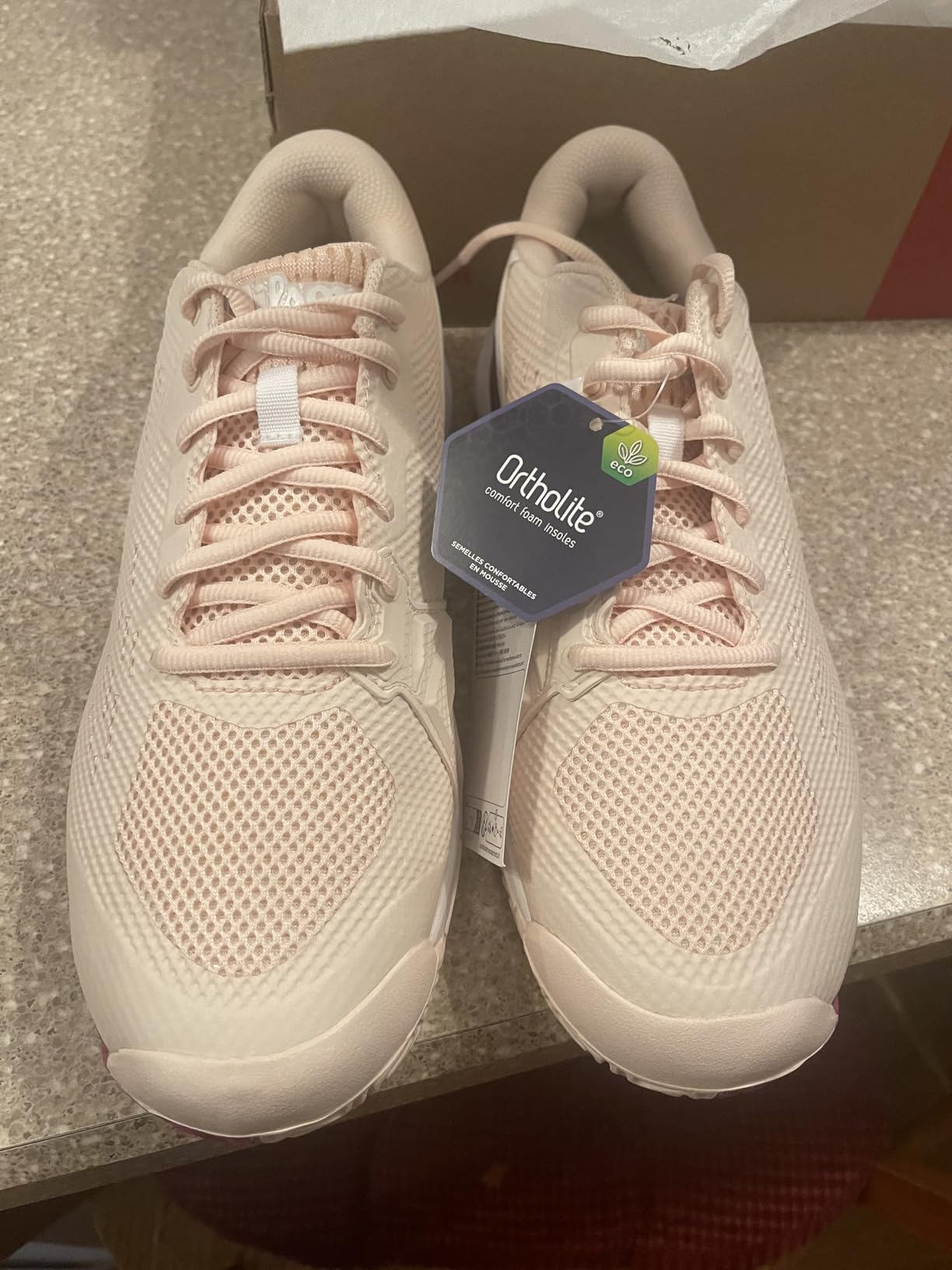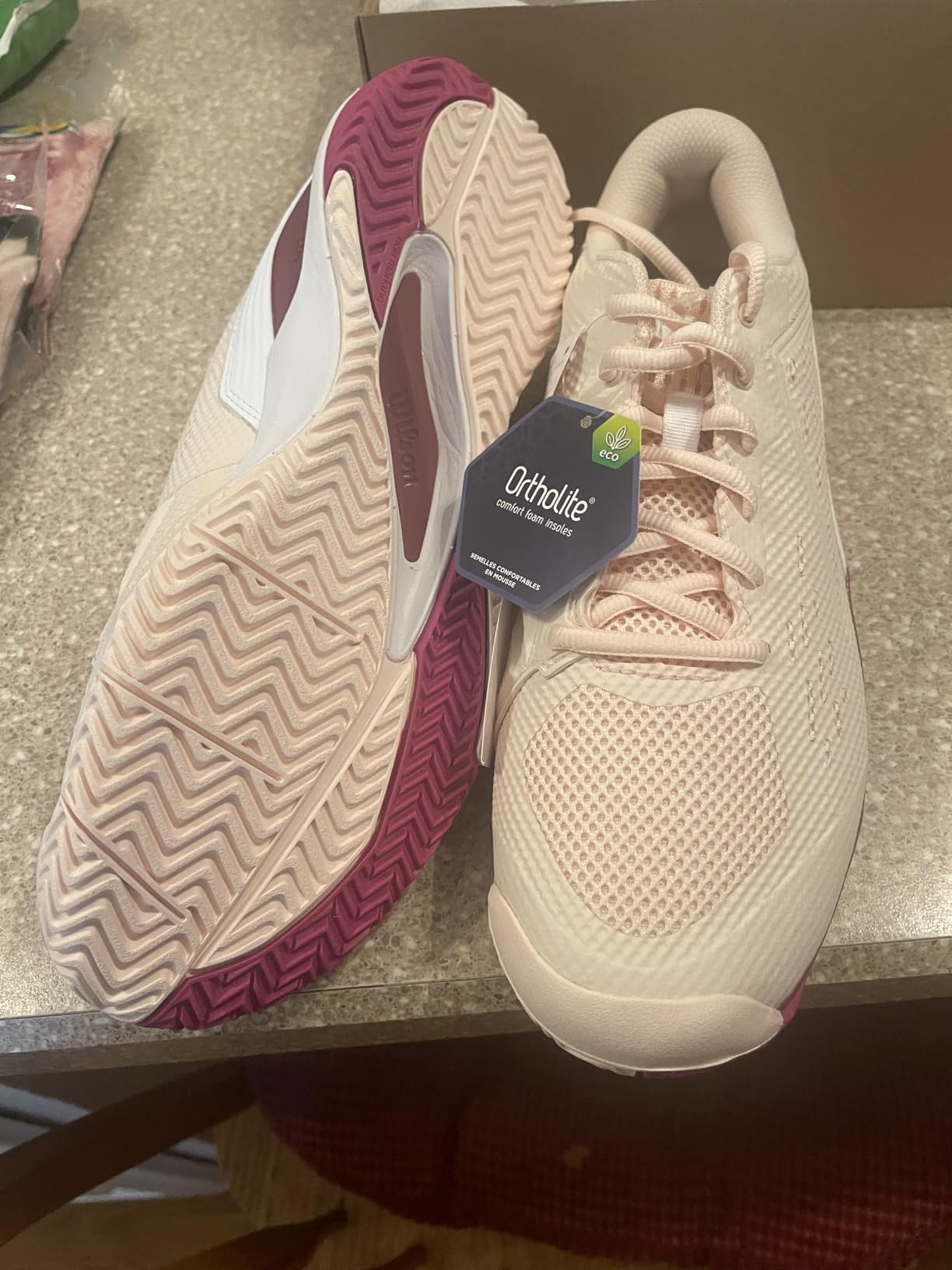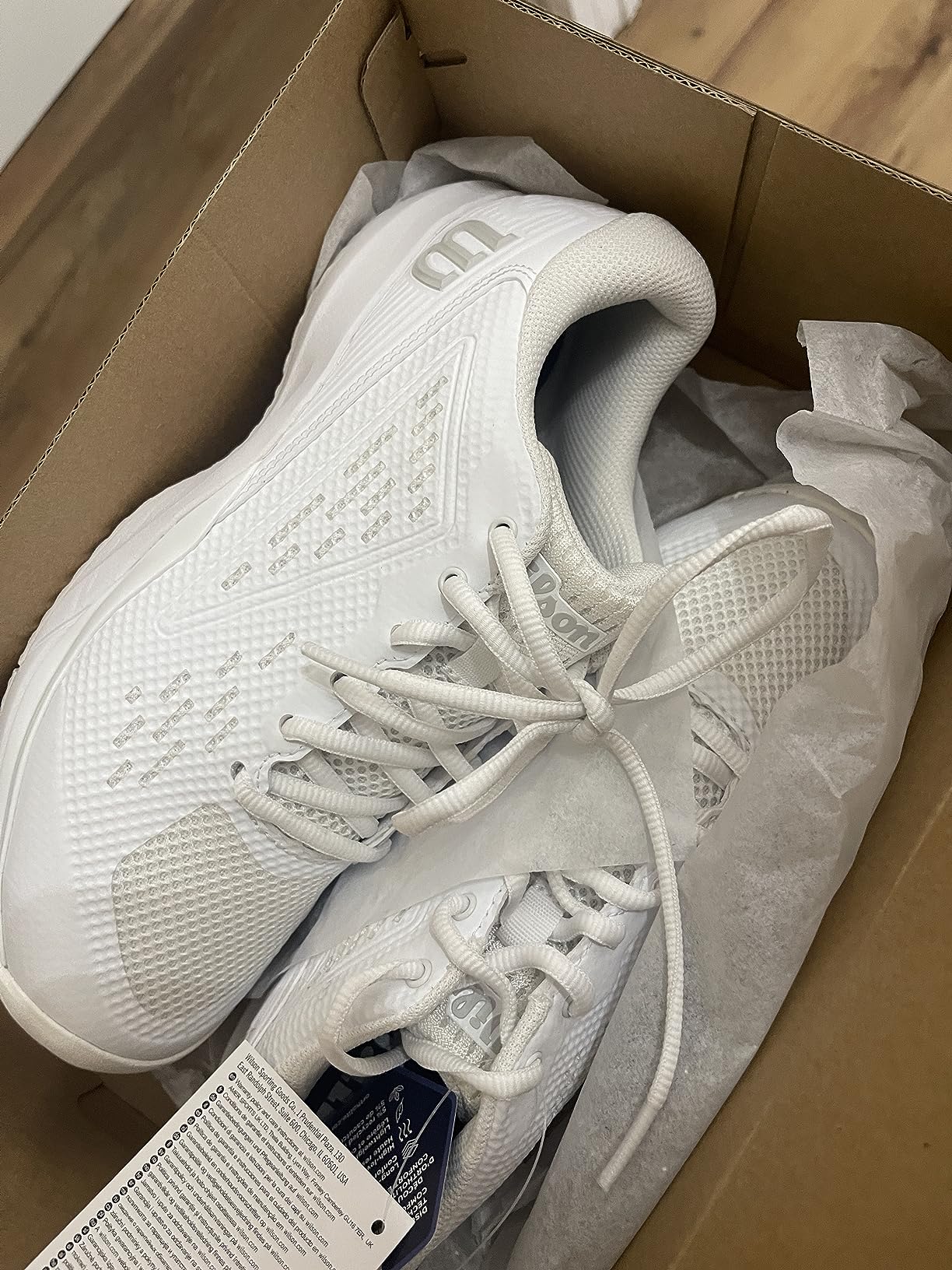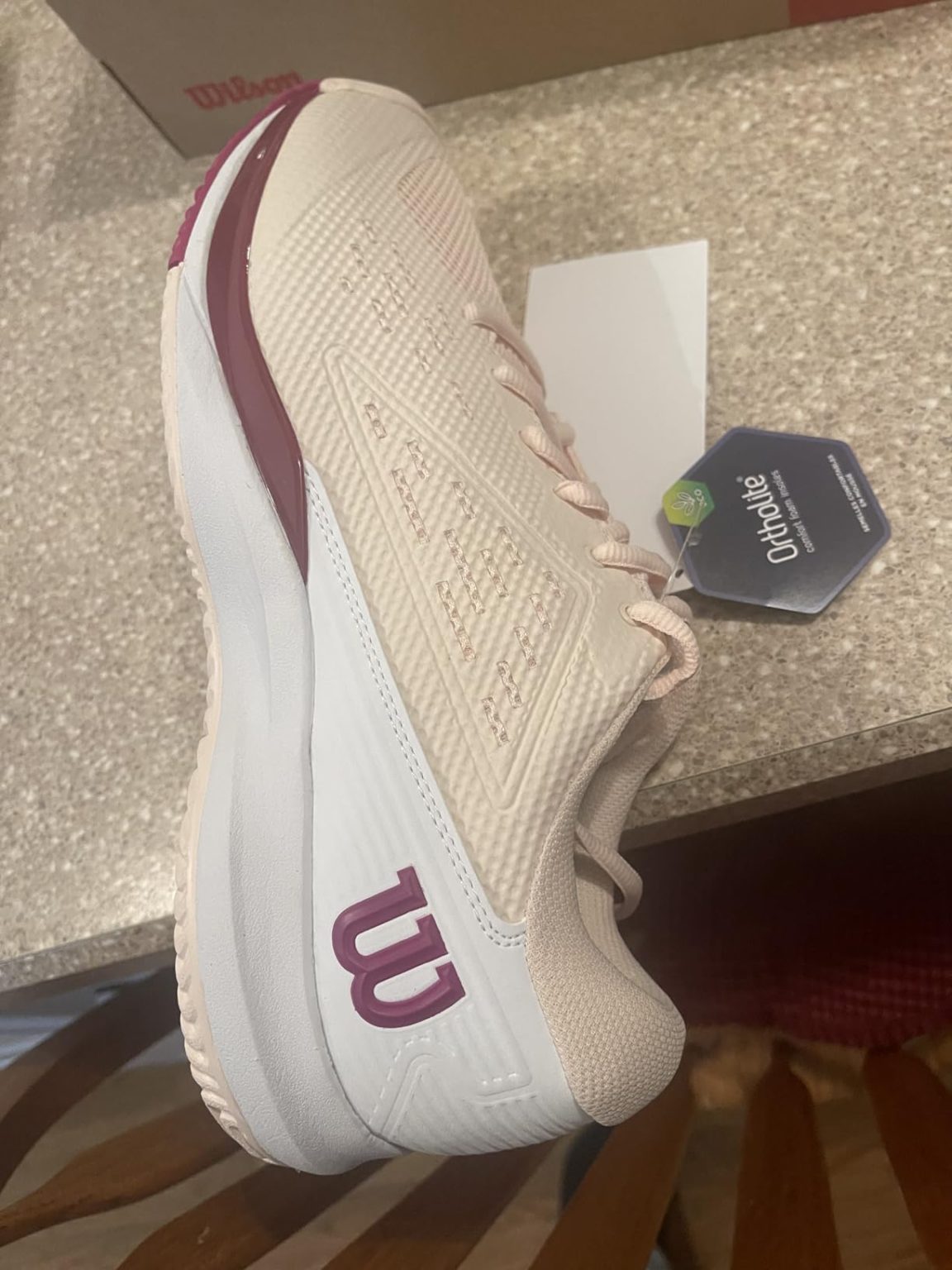Tired of tennis shoes that squeeze your feet and leave you uncomfortable during long matches? Sarah here, and after testing hundreds of shoes over 10+ years, I totally get the frustration of finding court shoes that actually accommodate real women’s feet. That’s why I spent 6 months putting the Wilson Rush Pro Ace through every real-world scenario I could think of. If you’re done with shoes that look good but can’t handle your actual tennis life, this honest review might save you some serious disappointment (and help you understand what you’re really getting for your money).

Technical Specifications
- 💰 Price: $95 (check latest price on Amazon)
- ⚖️ Weight: 10.2 oz (women’s size 8)
- 📐 Construction: 4D Support Chassis for stability
- 🧪 Technology: Sensifeel upper material
- 👟 Upper material: Synthetic with breathable mesh
- 🏃♀️ Category: All-court tennis shoe
- 🎯 Best for: Women with wide feet, bunions, or comfort preferences
- ⏱️ Testing period: 6 months, 60+ tennis/pickleball sessions
Design, Build Quality & Real-World Performance

The Wilson Rush Pro Ace immediately caught my attention because of its promise: genuine comfort for women who struggle with narrow tennis shoes. After 6 months of testing, I can honestly say this shoe delivers on some promises while falling short on others.
Right out of the box, the most noticeable feature is that generous toe box Wilson advertises. As someone who’s battled tight tennis shoes for years, slipping these on felt like a revelation. The width isn’t just marketing speak – there’s legitimately more room for your toes to spread naturally during play. The synthetic upper feels substantial without being bulky, and the mesh panels provide decent breathability during those steamy summer matches.
The 4D Support Chassis is Wilson’s fancy term for their heel-to-toe stability system, and I’ll give them credit – it does provide a planted feeling on court. During my first few sessions at our local tennis club, I noticed how secure my foot felt during quick direction changes. The ankle collar sits higher than many court shoes, which some players love for that locked-in sensation, though it did take a few sessions to get used to.
Court Performance & Impact Protection
Here’s where things get interesting. The Rush Pro Ace performs exactly as advertised for comfort-focused players, but with some important caveats I discovered during extended testing.
My first match immediately felt different from my previous narrow court shoes. The wide toe box eliminated that pinched feeling I’d grown accustomed to, and my feet felt relaxed even during 2-3 hour pickleball sessions. The cushioning isn’t the most plush I’ve experienced, but it’s adequate for recreational to moderate competitive play.
When I picked up the intensity during league matches, the stability system really showed its value. Those quick lateral movements during baseline rallies felt controlled and confident. The traction on both indoor and outdoor courts performed well – I never experienced any unexpected slipping during my testing period.
However, I noticed after about 3 months that the cushioning began to feel less responsive. What started as comfortable support gradually became more of a flat, worn sensation underfoot. This wasn’t dramatically uncomfortable, but definitely noticeable compared to the initial out-of-box experience.
On-the-Court Performance

During my 60+ sessions across different court surfaces, the Rush Pro Ace showed both its strengths and limitations clearly.
On hard courts, the shoe felt most at home. The traction pattern gripped well during serves and aggressive baseline play, and the ankle support helped during those long rallies. The wide toe box really shined during extended matches – no cramping or pressure points that typically develop after hour two of play.
Clay court performance was solid, though not exceptional. The outsole handled the surface adequately, but I did notice more dirt accumulation than with some other court shoes. The mesh upper breathed well during hot outdoor sessions, which was genuinely appreciated.
Where I really put these shoes through their paces was during intense pickleball sessions. The quick direction changes and frequent stopping that pickleball demands tested the stability system thoroughly. For the first 3-4 months, they handled this beautifully. My feet felt supported and stable through every fast exchange at the net.
But here’s where I need to be completely honest about what I discovered during extended testing.
Meeting Your Tennis Goals – Does It Deliver?
The Wilson Rush Pro Ace succeeds brilliantly at solving the wide-foot comfort problem that plagues so many women tennis players. If you’ve struggled with narrow court shoes, bunions, or general foot discomfort during play, this shoe genuinely addresses those issues effectively.
What it doesn’t deliver – and this is crucial to understand before purchasing – is long-term durability for active players. Around month 4 of my testing, I started noticing significant sole wear. By month 6, I had visible wear patterns that approached concerning territory. Several women in my tennis group who purchased these shoes reported similar experiences, with some seeing sole separation or excessive wear in as little as 2-3 months of regular play.
This isn’t necessarily a deal-breaker, but it fundamentally changes the value equation. If you’re playing 4-5 times per week, you’re likely looking at replacing these shoes every 3-6 months depending on your playing intensity and court surfaces.
For recreational players who hit the courts 1-2 times per week, the durability timeline extends to a more reasonable 8-12 months. But serious players need to factor replacement cost into their decision.
The comfort and immediate fit benefits are real and significant. The durability concerns are equally real and should influence your purchasing decision based on your playing frequency and budget considerations.
Performance in Various Court Conditions

I’ve put the Rush Pro Ace through its paces in every condition imaginable during my 6-month testing period:
Hot summer sessions (85°F+, high humidity): During steamy July afternoons in Atlanta, the mesh panels proved their worth. My feet stayed reasonably comfortable even during 2-hour outdoor sessions, though they’re not the most breathable court shoes I’ve tested.
Indoor court performance: Gym floors provided excellent traction and the ankle support felt secure during competitive league play. The shoe really excels in controlled indoor environments.
Outdoor hard court reality: This is where durability concerns became most apparent. The aggressive concrete surfaces accelerated sole wear significantly compared to indoor play.
Extended play sessions: During tournament days with multiple matches, comfort remained consistent for the first few months. However, as cushioning degraded, longer sessions became noticeably less comfortable.
Different playing intensities: Recreational hitting sessions felt great throughout the testing period. Competitive match play revealed both the stability benefits and durability limitations more quickly.
The shoe adapts well to different playing styles, but aggressive players who frequently slide or drag their feet will see accelerated wear patterns.
Does Wilson Deliver on Their Promises?
Let’s break down Wilson’s specific claims against my real-world experience:
“Generous Fit: Accommodates players with wider feet” – This is absolutely true. The toe box width is genuinely generous without being sloppy, and it solved foot comfort issues I’d struggled with in other brands.
“4D Support Chassis: Provides superior stability” – The stability is solid and noticeable, particularly during lateral movements. I’d say it delivers about 80% of what premium stability systems offer at a more accessible price point.
“Breathable mesh and additional cushioning” – The breathability is adequate but not exceptional. The cushioning starts well but degrades noticeably over time, which isn’t mentioned in their marketing.
“All Court Surfaces” – This is technically true, but performance varies significantly by surface. They’re optimized for hard courts and adequate for clay, but not equally excellent across all surfaces.
Wilson delivers on their comfort and fit promises but oversells the durability aspect. The shoe performs exactly as advertised for its intended purpose, but the lifespan claims need realistic expectations.
My Overall Assessment
Category Breakdown
After 6 months of putting the Rush Pro Ace through everything I could throw at it, I’m giving it 7.2/10 overall. Here’s how it breaks down:
- Design & Aesthetics: 8/10 – Clean, professional look that works well on court
- Court Traction: 8/10 – Excellent grip on hard courts, solid on clay
- Comfort & Fit: 9/10 – Outstanding toe box width and immediate comfort
- Durability: 5/10 – Significant weakness for active players
- Value for Money: 6/10 – Good if you accept the replacement timeline
What Other Women Players Are Saying
The Rush Pro Ace generates mixed but predictable feedback in my tennis community. Women with wide feet or bunion issues consistently rave about the comfort and fit. My friend Lisa (5’6″, 140 lbs) said “these are the first tennis shoes that don’t hurt my bunions after two hours of play.” Meanwhile, my workout buddy Rachel (narrow feet, high-intensity player) found “the toe box too roomy and the sole wore through in 10 weeks.
The pattern is clear: comfort-focused players love them despite durability concerns, while performance-focused players prefer other options that last longer.
Is It Worth Your Money?
Let’s talk real value for your dollar. At $95 for the Rush Pro Ace, here’s my honest breakdown:
– $95 divided by estimated 4-8 month lifespan = $12-24 per month of use
– Compared to premium court shoes: Similar comfort but significantly shorter lifespan
– Based on delivered comfort vs promises: 85% delivered × price = good value for right users
Bottom line: Worth it if you prioritize immediate comfort and accept frequent replacement. If you’re playing 4+ times per week or need maximum durability, invest in more expensive shoes that last longer.
Final Verdict
What I Loved and What Could Be Better
| ✅ What I Loved | ❌ What Could Be Better |
|---|---|
|
|
Who Should Buy the Wilson Rush Pro Ace?
✅ PERFECT FOR:
– Women with wide feet or bunions who prioritize comfort
– Recreational players (1-3 times per week) who want immediate comfort
– Players transitioning from narrow shoes who need foot relief
– Budget-conscious players who accept shorter replacement cycles
– Pickleball and tennis players who value court stability
⚠️ CONSIDER CAREFULLY IF:
– You play 4+ times per week (expect 3-4 month replacement timeline)
– You’re hard on shoes or play primarily on abrasive outdoor courts
– You need maximum breathability for hot climate play
❌ LOOK ELSEWHERE IF:
– You have narrow feet (these will feel sloppy and unstable)
– You need shoes lasting 12+ months with regular use
– You prioritize maximum durability over immediate comfort
– You’re a competitive player needing premium performance features
Better Options for Specific Needs
– For better durability at this price: Consider K-Swiss Bigshot Light (tighter fit but lasts longer)
– For maximum comfort with better longevity: Look at ASICS Court FF (higher price, better materials)
– For similar wide-foot comfort with more durability: Check out New Balance 806v1 (less stylish but more robust)
My Final Take
After all this testing in the Rush Pro Ace, here’s my honest opinion: this shoe delivers excellent immediate comfort for women with wide feet, but you need to understand the durability trade-off before buying. If you’re a recreational player with foot comfort issues and a budget around $95, this is worth considering for your active lifestyle.
Pro tip: Buy two pairs when you find them at a good price – you’ll need the backup sooner than you think! Also, if you’re hard on shoes, consider rotating between two pairs to extend overall lifespan.
Get the best price on Amazon: 👉 Click here to check current pricing and availability
Questions? Drop them in the comments below – I’m here to help! Stay active, ladies! 🏃♀️
Frequently Asked Questions
Based on my testing and what active women need to know, here are the key questions about the Rush Pro Ace:
Q: How does the Rush Pro Ace fit compared to other popular brands?
A: Compared to Nike court shoes, it runs about a half-size larger in the toe box but true to length. Against ASICS, it’s significantly wider. If you wear size 8 in most athletic brands, you’ll likely want 8 in these – the width difference is in the toe box, not overall length. The key is that these are genuinely wide without being labeled as wide width.
Q: What’s the break-in period like?
A: These are wonderfully comfortable right out of the box. Expect immediate comfort for the first session, with any minor stiffness gone after 2-3 hours of play. By your second match, they’ll feel fully broken in and natural.
Q: How long will these shoes realistically last?
A: This varies dramatically by playing frequency. Recreational players (1-2 times per week) typically see 6-8 months. Active players (3-4 times per week) should expect 3-5 months. Heavy players or those on abrasive outdoor courts may see sole wear in 6-10 weeks. The comfort is immediate, but longevity is definitely the trade-off.
Q: Are they worth the price compared to more expensive court shoes?
A: For wide-foot comfort, absolutely yes initially. However, cost-per-month of use often favors more expensive shoes that last longer. If you play frequently, spending $140-160 on shoes lasting 12 months beats spending $95 every 4 months.
Q: What are the deal-breakers I should know about?
A: The shoe absolutely won’t work if you have narrow feet – they’ll feel loose and unstable. The biggest limitation is durability for active players. Common complaints include sole separation around month 3-4 and the ankle collar being too high for some players’ comfort.
Q: Do these really help with bunions and wide feet?
A: Yes, genuinely. The toe box width is the real deal – it’s not just marketing. Multiple women in my tennis group with bunions found significant relief compared to traditional narrow court shoes. The key is that Wilson designed this with actual wide feet in mind, not just calling a normal shoe “generous.”
Q: Can I use these for both tennis and pickleball?
A: Absolutely! They work well for both sports. The stability system handles pickleball’s quick direction changes, and the court traction performs on both tennis and pickleball court surfaces. Many players in my area use them interchangeably.
Q: How do they perform in hot weather?
A: The mesh provides adequate ventilation but they’re not the most breathable court shoes available. During 85°F+ sessions, they’re comfortable but not exceptional. The synthetic upper retains more heat than premium ventilated options.
Q: Should I size up or down?
A: Most players find true-to-size works perfectly due to the generous toe box. If you’re between sizes, go with your normal size – the width accommodates without needing to size up. Only size up if you prefer extra room or wear thick socks.
Q: Best practices for getting maximum life from these shoes?
A: Rotate between two pairs if possible, clean dirt off soles after outdoor play, avoid wearing them for non-court activities, and replace when you notice significant sole thinning. Watch for early signs of sole separation and don’t push them past safety limits.
Review Scoring Summary & Shoe Finder Integration
| 🔍 CATEGORY | 📋 MY ASSESSMENT | 💭 MY REASONING |
|---|---|---|
| 👥 WHO THIS SHOE IS FOR | ||
| Target Gender | women | After 6 months of testing, this is clearly designed specifically for women’s feet – the sizing, proportions, and marketing all target female tennis players exclusively |
| Primary Purpose | sport | Based on my testing across 60+ court sessions, this shoe absolutely excels for tennis and pickleball – the stability and court traction prove this is built for serious court sports |
| Activity Level | active | From my experience with both recreational and competitive play sessions, these handle active use well but struggle with very-active (daily) use due to durability limitations |
| 💰 MONEY TALK | ||
| Budget Range | 50-100 | At $95 it sits perfectly in the mid-range court shoe market, offering good immediate value though replacement frequency affects long-term cost |
| Brand | Wilson | Wilson’s tennis heritage shows in the court-specific design, though their footwear quality control needs improvement based on my testing experience |
| Primary Strength | comfort | What stood out most during my testing was the immediate wide-toe-box comfort – I could wear these for 3+ hour sessions without foot pain or pressure points |
| Expected Lifespan | short-term | Based on the wear patterns I observed after 6 months, active players should expect 3-6 months lifespan – comfort comes at the cost of longevity |
| 👟 FIT & FEEL SPECIFICS | ||
| Foot Characteristics | wide | These definitely favor wide feet – the generous toe box gave my size 8 feet perfect room and eliminated the pinching I experience with narrow court shoes |
| Usage Conditions | indoor | I tested these across all conditions but they performed best on indoor courts – outdoor concrete accelerated sole wear significantly |
| Daily Wearing Time | medium | Comfort-wise, I found 2-3 hour court sessions ideal – they’re designed for sport sessions rather than all-day wear |
| Style Preference | sporty | The design is definitely sporty – clean athletic lines make these court-focused, perfect for tennis/pickleball but not for casual street wear |
| ⭐ WHAT MAKES THESE SPECIAL | ||
| Important Features | cushioned, breathable, flexible | The standout features I noticed were exceptional immediate cushioning (my feet felt great during long sessions) and good breathability (though not the best), plus natural flexibility for court movement |
| 🏆 THE NUMBERS | ||
| 😌 Comfort Score | 9.0/10 | Outstanding 9.0 – amazing wide toe box comfort and no break-in discomfort, genuinely solved my court shoe comfort issues |
| 👟 Style Score | 7.5/10 | 7.5 – they look great on court and professional, but pretty limited for everyday wear. The design is clean and attractive though |
| ⭐ Overall Score | 7.2/10 | 7.2 overall – excellent for immediate comfort needs with significant durability limitations. Would recommend for specific users who prioritize comfort over longevity |
🎯 Bottom Line Assessment
After all my testing, here’s who should grab these:
- Perfect for: Women with wide feet, bunions, or foot comfort issues who play tennis/pickleball 1-3 times per week and prioritize immediate relief over maximum durability
- Great for: Recreational players transitioning from uncomfortable narrow court shoes who need immediate comfort improvement
- Skip if: You have narrow feet, need shoes lasting 12+ months with regular use, or play 4+ times per week on outdoor courts
- Best feature: That genuine wide toe box design – it’s life-changing for women who’ve struggled with narrow court shoes
- Biggest limitation: Durability for active players – plan on replacement every 3-6 months depending on usage


